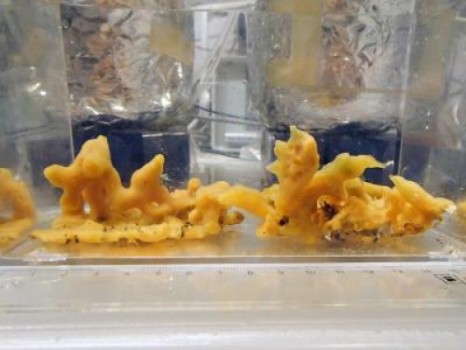当前位置: Language Tips> 双语新闻
Theory on origin of animals challenged: Some animals need extremely little oxygen
 |
|
Sea sponge Halichondria panicea was used in the experiment at the University of Southern Denmark. |
|
One of science's strongest dogmas is that complex life on Earth could only evolve when oxygen levels in the atmosphere rose to close to modern levels. But now studies of a small sea sponge fished out of a Danish fjord shows that complex life does not need high levels of oxygen in order to live and grow. The origin of complex life is one of science's greatest mysteries. How could the first small primitive cells evolve into the diversity of advanced life forms that exists on Earth today? The explanation in all textbooks is: Oxygen. Complex life evolved because the atmospheric levels of oxygen began to rise app. 630 -- 635 million years ago. However new studies of a common sea sponge from Kerteminde Fjord in Denmark shows that this explanation needs to be reconsidered. The sponge studies show that animals can live and grow even with very limited oxygen supplies. In fact animals can live and grow when the atmosphere contains only 0.5 per cent of the oxygen levels in today's atmosphere. "Our studies suggest that the origin of animals was not prevented by low oxygen levels," says Daniel Mills, PhD at the Nordic Center for Earth Evolution at the University of Southern Denmark. Together with Lewis M. Ward from the California Institute of Technology he is the lead author of a research paper about the work in the journal PNAS. A little over half a billion years ago, the first forms of complex life -- animals -- evolved on Earth. Billions of years before that life had only consisted of simple single-celled life forms. The emergence of animals coincided with a significant rise in atmospheric oxygen, and therefore it seemed obvious to link the two events and conclude that the increased oxygen levels had led to the evolution of animals. "But nobody has ever tested how much oxygen animals need -- at least not to my knowledge. Therefore we decided to find out," says Daniel Mills. The living animals that most closely resemble the first animals on Earth are sea sponges. The species Halichondria panicea lives only a few meters from the University of Southern Denmark's Marine Biological Research Centre in Kerteminde, and it was here that Daniel Mills fished out individuals for his research. "When we placed the sponges in our lab, they continued to breathe and grow even when the oxygen levels reached 0.5 per cent of present day atmospheric levels," says Daniel Mills. This is lower than the oxygen levels we thought were necessary for animal life. The big question now is: If low oxygen levels did not prevent animals from evolving -- then what did? Why did life consist of only primitive single-celled bacteria and amoebae for billions of years before everything suddenly exploded and complex life arose? "There must have been other ecological and evolutionary mechanisms at play. Maybe life remained microbial for so long because it took a while to develop the biological machinery required to construct an animal. Perhaps the ancient Earth lacked animals because complex, many-celled bodies are simply hard to evolve," says Daniel Mills. His colleagues from the Nordic Center for Earth Evolution have previously shown that oxygen levels have actually risen dramatically at least one time before complex life evolved. Although plenty of oxygen thus became available it did not lead to the development of complex life.
|
据外媒2月17日报道,科学界一直认定,地球上的复杂生物是在大气中的氧气含量达到现在的标准时才逐渐进化出来的。但是,学者研究丹麦海绵后认定,复杂生物的生存和发展并不需要高浓度的氧气,并向传统理论发起挑战。 复杂生物的起源一直都是科学界的难解之谜。原始的细胞如何进化成了当今在地球上的高等生命形态?教科书上一般采用“氧气”作为答案,并解释说6.3亿至6.35亿年前大气中氧气浓度上升,地球上因此进化出复杂的生命形态。 但是,南丹麦大学的博士生丹尼尔•米尔斯从丹麦一处峡谷中打捞出海绵,并加以研究后表示,需要重新审视这一传统学说。研究发现,这些海绵在仅有当今大气含氧量0.5%的极端环境下,仍能生存和成长。 米尔斯说:“我们的研究表明氧气浓度偏低并不是阻碍生物起源的真正原因。”米尔斯和加州理工学院的刘易斯•M•沃德就此联合撰写论文,并且在《美国国家科学院院刊》上发表。 5亿多年以前,“动物”这一复杂的生命形式刚刚出现。在此之前的数十亿年里,仅有的生命形式都为单细胞生物。而就在大气中氧气含量显著上升的时候,动物也恰巧出现,所以人们自然把这两件事关联起来,生物进化得益于氧气增加。 米尔斯说:“但是据我所知,从来没有人测试过动物究竟需要多少氧气。所以我们决定一探究竟。”当今地球上海绵最接近早期生物,南丹麦大学附近就有。米尔斯近水楼台,钓上几个进行研究。米尔斯说:“我们把海绵放进实验室,在氧气含量仅为当今大气的0.5%时,它们仍能继续呼吸和生长。” 实验证明极低的含氧量没有阻止生物的生长。米尔斯说: “肯定有其他的生态或进化机制发挥作用。也许需要一段时间才能产生出构建动物的生物机制,生命因此长期停留在单细胞状态。也许进化出复杂、多细胞的生物就是很困难,所以地球上当时才没有动物。” 另有研究表明,在进化出复杂动物之前,地球上的氧气含量已经显著增加了至少一次。不过,丰富的氧气并没有直接带来生物的进化。 相关阅读 (信莲 编辑:王琦琛)
|
|
|
上一篇 : 移动技术:“韩流”的推手
下一篇 : 白宫前女义工:希拉里抹黑受害人
关注和订阅


电话:8610-84883645
传真:8610-84883500
Email: languagetips@chinadaily.com.cn